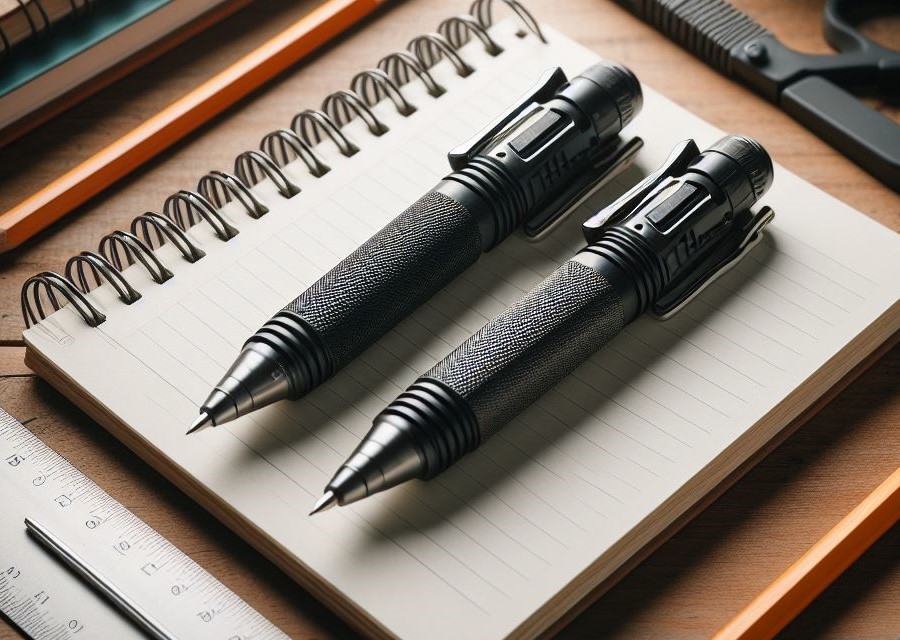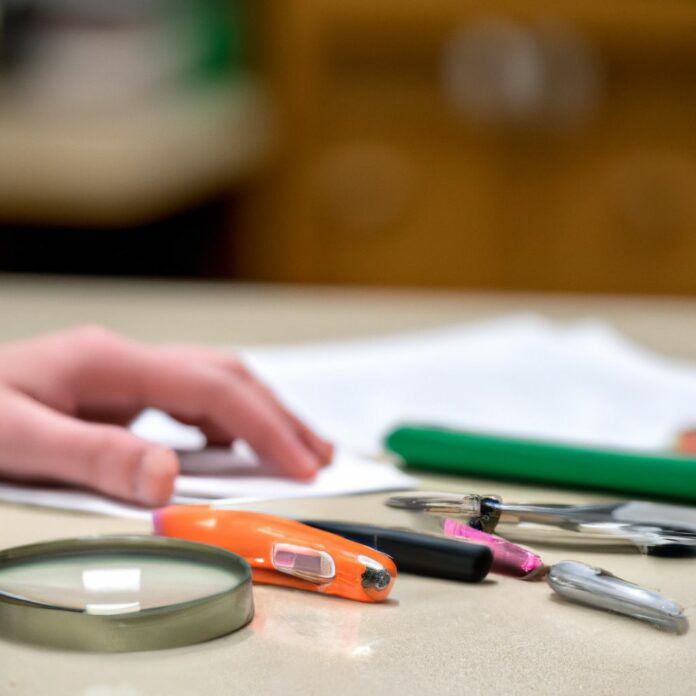Tactical pens have gained popularity in recent years due to their multifunctional design and usefulness in self-defense situations. However, the question arises: are tactical pens allowed in schools?
Understanding the implications requires examining the nature of tactical pens, school policies on weapons, concerns and controversies surrounding their use, and exploring alternatives for personal safety.
Firstly, tactical pens are practical writing instruments that are also designed with additional features such as a pointed tip, sturdy construction, or even a glass breaker. While they may have a resemblance to weapons, it is crucial to establish if they are officially classified as such.
Examining school policies on weapons is essential to determine whether students are allowed to carry tactical pens. School policies generally have a clear definition of what constitutes a weapon and specific regulations regarding their possession.
Understanding how tactical pens align with these definitions and rules will shed light on their permissibility in educational settings.
Concerns and controversies surrounding tactical pens revolve around their weapon-like appearance, potential misuse or threat to others, and the overall impact on the learning environment. These concerns need to be addressed to ensure the safety and well-being of all students and staff.
Exploring alternatives to tactical pens highlights the importance of implementing comprehensive school security measures, providing self-defense education and training, and utilizing non-weapon tools for personal safety.
What are Tactical Pens?

Tactical pens are multi-purpose tools that are designed for practicality and self-defense. They are typically crafted from durable materials such as aircraft-grade aluminum and feature a pointed tip that can be utilized for striking or shattering glass in emergency situations.
Additionally, these pens frequently come with a replaceable ink cartridge, making them functional writing instruments as well.
A compelling real-life account underscores the usefulness of tactical pens when a woman effectively employed her own tactical pen to protect herself during an assault.
By targeting sensitive areas, she was able to incapacitate her attacker, enabling her to escape and seek assistance. This incident serves as a powerful testament to the efficacy and value of tactical pens as tools for personal safety.
When considering tactical pens, it is essential to acknowledge their purpose and functionality without insinuating that they are inherently weapons. Instead of questioning whether tactical pens qualify as weapons, it is more accurate to explore their features and design.
By comprehending the practical applications of tactical pens and their potential advantages for personal safety, individuals can make informed choices about whether or not to carry them.
Importantly, educational institutions often have strict regulations concerning weapons, making it crucial for individuals to familiarize themselves with these policies prior to bringing a tactical pen onto school premises.
Maintaining open communication and collaboration between schools, parents, and students regarding safety concerns is vital, as it ensures that everyone is well-informed and working together to establish a secure environment.
Are Tactical Pens Weapons?
Let’s dive into this intriguing question and explore the definition of weapons as well as the classification of tactical pens. Discover the fascinating details behind these versatile tools and gain a better understanding of their potential implications in various settings.
Brace yourself for eye-opening insights that may challenge your preconceptions about tactical pens.
Definition of Weapons
The importance of defining weapons becomes evident when discussing the use of tactical pens. When we talk about weapons, we generally refer to instruments that are specifically designed or used to cause harm or damage to living beings or objects.
This category includes a wide range of tools and devices, such as firearms, knives, explosives, or blunt objects.
Within the context of school policies, how weapons are defined plays a crucial role in determining whether or not tactical pens are allowed on school premises. School policies usually provide specific definitions that outline which items are considered weapons and, therefore, prohibited.
It is essential to examine these policies to see if they explicitly include or exclude tactical pens from the definition of weapons.
A real-life incident illustrates the significance of having clear definitions for weapons. It involves a student who faced disciplinary action for possessing a tactical pen at school. The pen, which had various features for self-defense, was classified as a weapon due to its design and potential to cause harm.
This incident sparked a debate among school administrators, parents, and students about the permissibility of tactical pens in schools.
This story highlights the necessity of clear definitions when it comes to weapons. It underscores the importance of open dialogue and collaboration between schools, parents, and students to effectively address safety concerns.
By promptly reporting potential threats or concerns to the appropriate authorities, schools can ensure the safety and well-being of their students.
Classification of Tactical Pens
Below is a table showcasing the classification of tactical pens:
| Regular Pens | Tactical Pens |
| Designed for writing purposes | Designed for self-defense and emergency situations |
| No additional features | May include features such as a glass breaker, LED flashlight, or DNA collector |
| Typically made of plastic or metal | Constructed with durable materials like aluminum or stainless steel for enhanced strength |
Tactical pens are distinct from regular pens as they are specially designed for self-defense and emergency purposes. They often come equipped with additional features like a glass breaker, LED flashlight, or DNA collector. Made of durable materials like aluminum or stainless steel, tactical pens are sturdier compared to regular pens.
Fact: Tactical pens can serve as a discreet and practical self-defense tool, providing individuals with a portable and inconspicuous means of protection.
Can Students Carry Tactical Pens in Schools?

Can students carry tactical pens in schools? Let’s dive into the intriguing world of school policies on weapons, the definition of weapons in these policies, and the specific rules about carrying tactical pens.
Discover what schools allow and what they don’t when it comes to these unique writing tools. Buckle up as we explore the fine line between practicality and safety within the confines of educational institutions.
School Policies on Weapons
When it comes to school policies on weapons, it is important to consider several key factors:
- Overview of policies: Schools have strict school policies on weapons in place that outline the restrictions and rules for carrying weapons on school premises.
- Definition of weapons: These school policies specifically define what constitutes a weapon, including whether tactical pens are included or excluded from these definitions.
- Specific rules about carrying tactical pens: Schools may have specific rules or regulations regarding the possession and use of tactical pens. It is crucial to be aware of any exceptions or allowances for special circumstances.
Adhering to these school policies on weapons is crucial for the safety and well-being of students. By understanding and abiding by these policies, students can contribute to a secure learning environment.
The Definition of Weapons in School Policies
In school policies, the definition of weapons in school policies holds significant importance in determining what items are permissible on school premises.
The definition generally encompasses firearms, knives, explosives, and other hazardous objects that possess the potential to cause harm or injury to others. However, the classification of tactical pens as weapons within school policies is a topic of ongoing debate.
Some argue that their strong construction and pointed tips indicate their potential to be used as weapons, while others contend that their primary function as writing instruments should exempt them from being considered weapons.
For students, parents, and school administrations, it is crucial to understand the specific rules and regulations pertaining to the possession and use of tactical pens in schools. These regulations can include restrictions on carrying them, guidelines for their use, and any exceptions or allowances for special circumstances.
Specific Rules about Carrying Tactical Pens
When it comes to carrying tactical pens in schools, it is crucial to follow the specific rules about carrying tactical pens. These rules exist because tactical pens are generally considered potential weapons due to their design and capabilities.
- School policies on weapons typically prohibit carrying any items that could be used as weapons, including tactical pens.
- The main purpose of these rules is to ensure the safety and well-being of all students and staff members.
- It is rare for there to be exceptions or allowances for carrying tactical pens in schools, and if any are made, they would require special circumstances or permissions from school administrators.
Adhering to these specific rules is essential for maintaining a safe and secure learning environment.
Concerns and Controversies

Concerns and controversies surrounding the use of tactical pens in schools are abundant. Delving into the weapon-like appearance, potential misuse or threat, and effects on the learning environment, we uncover a range of perspectives and opinions.
From the implications for safety and security to the impact on students’ focus and well-being, this section explores the various dimensions of this contentious issue.
As we navigate through each sub-section, prepared to be enlightened and challenged on this hotly debated topic.
Weapon-like Appearance
The weapon-like appearance of tactical pens can raise concerns regarding their potential misuse or misidentification.
- Tactical design: Tactical pens are designed to resemble regular pens, but with additional features that give them a more robust and rugged appearance.
- Sturdy construction: These pens are usually made from durable materials such as aircraft-grade aluminum or stainless steel, adding to their weapon-like appearance.
- Sharp points: Some tactical pens feature pointed ends that can be used for self-defense purposes, which contributes to their weapon-like appearance.
- Aggressive styling: Tactical pens often have a more aggressive design aesthetic, with textured grips, knurled surfaces, or tactical patterns, further enhancing their weapon-like appearance.
- Potential confusion: The distinct appearance of tactical pens may lead to confusion or mistaken identification as weapons, especially in situations where their function is not widely known.
- Perceived threat: The weapon-like appearance of tactical pens can create concerns regarding their potential misuse or use as a threat, causing unease in certain environments.
- Safety considerations: It is important to educate individuals about the intended purpose of tactical pens to prevent undue alarm or confusion.
Potential Misuse or Threat
Potential misuse or threat concerning tactical pens must be carefully considered. These pens, specifically designed for self-defense, possess the potential to cause harm if they are not used properly.
The sharp tips and solid construction of tactical pens make them capable of inflicting injuries. Therefore, it is crucial to emphasize the significance of responsible use and provide proper education on the safe handling of these pens.
Schools and authorities need to address the potential risks associated with tactical pens and establish clear guidelines on their possession and utilization.
Implementing safety measures is essential to prevent any abuse or harm arising from the possession of these pens. By encouraging open dialogue and collaboration, schools can ensure a secure learning environment and empower students to report any possible threats or concerns.
It is of utmost importance to offer alternative tools for personal safety and provide students with education on self-defense, thereby enabling them to explore non-weapon options.
Effects on the Learning Environment
The presence of tactical pens in schools may have several effects on the learning environment.
- Distractions: The sight of students carrying tactical pens could potentially be distracting to other students, diverting their attention from their studies.
- Intimidation: The presence of tactical pens may create a sense of intimidation or fear among students, impacting their overall comfort and well-being in the learning environment.
- Risks to other students: In certain situations, the possession of tactical pens could pose a risk to the safety of other students if misused or mishandled.
- Authority concerns: The use of tactical pens by students might pose challenges for teachers and school administrators in maintaining control and authority within the classroom.
- Responsibility: Allowing students to carry tactical pens may necessitate additional measures to ensure responsible use and prevent any potential incidents or accidents.
Alternatives to Tactical Pens

When it comes to ensuring safety in schools, it’s important to consider alternatives to tactical pens. In this section, we’ll explore various options that can help enhance security and personal safety without resorting to traditional weapons.
From school security measures to self-defense education and training, we’ll cover the tools and strategies that empower individuals to protect themselves.
Additionally, we’ll touch upon non-weapon tools, discuss school policies, and emphasize the significance of open dialogue and collaboration. Safety should be a priority, and these alternatives offer practical solutions for a secure learning environment.
School Security Measures
Schools implement various security measures, known as school security measures, to ensure the safety of students.
- One of these measures is having armed security personnel on staff to deter violence and respond to any potential threats.
- Another measure is the installation of surveillance cameras in key areas to monitor activities and identify any suspicious behavior.
- Controlled access points, such as locked doors or security checkpoints, are also implemented to prevent unauthorized individuals from entering the premises.
- Regular drills, such as active shooter drills or lockdown drills, are conducted to prepare students and staff for emergency situations and ensure a quick and orderly response.
- In addition, schools have efficient communication systems in place to alert students, staff, and parents in case of emergencies and provide timely updates.
All of these school security measures aim to create a safe and secure learning environment for everyone in the school community.
Self-Defense Education and Training
When it comes to self-defense education and training, it is important to equip students with the necessary skills and knowledge to protect themselves in potentially dangerous situations.
- Teaching basic self-defense techniques: Schools should prioritize providing self-defense education and training programs to students. By learning basic techniques such as blocking, striking, and self-awareness, students can develop the confidence and ability to defend themselves if needed.
- Promoting situational awareness: Self-defense education and training should also emphasize the importance of being aware of one’s surroundings and recognizing potential threats. This includes teaching students how to assess their environment, identify potential risks, and make informed decisions to ensure their safety.
- Encouraging assertiveness and self-confidence: Self-defense education and training should focus on empowering students to assert themselves and protect their personal boundaries. Building self-confidence is crucial in helping students stand up for themselves and deter potential attackers.
A study conducted by the National Institute of Justice found that self-defense training can reduce the risk of sexual assault by as much as 50%. This highlights the significant impact that self-defense education and training can have in promoting personal safety and empowering students.
Non-Weapon Tools for Personal Safety
When it comes to personal safety, there are several non-weapon tools for personal safety that can be helpful in various situations:
- Keychain alarms: These small devices can emit a loud noise when activated, which can attract attention and potentially scare off an attacker.
- Pepper sprays: Non-weapon tools for personal safety like pepper sprays contain a chemical compound that can temporarily incapacitate an assailant by causing irritation to the eyes, nose, and throat.
- Self-defense classes: Non-weapon tools for personal safety include learning self-defense techniques that can empower individuals to protect themselves in dangerous situations. These classes teach effective strategies for escaping or neutralizing threats.
Considering your personal preferences and circumstances, it’s essential to choose the non-weapon tool for personal safety that aligns with your needs and comfort level. It is also important to familiarize yourself with the local regulations and restrictions surrounding the use of these tools.
Summary of School Policies and Considerations
When it comes to school policies and considerations, tactical pens are a hot topic. These pens are generally seen as potentially dangerous weapons on school premises, which is why they are prohibited in most schools. However, it is important to note that schools have specific rules and regulations in place regarding the possession and use of tactical pens.
While tactical pens are generally not allowed, there may be exceptions or allowances for special circumstances. For example, students with disabilities who may need alternative means of self-protection may be granted permission to have tactical pens.
It is crucial for students and parents to familiarize themselves with and adhere to these policies in order to ensure the safety of everyone in the school environment.
Open dialogue and collaboration are encouraged between schools, parents, and students when it comes to safety concerns. It is essential to have ongoing conversations to address any potential threats or concerns related to tactical pens or any other weapons.
If anyone comes across such issues, it is important to report them to the appropriate authorities.
Aside from tactical pens, there are other alternatives for personal safety that can be considered. Schools can implement security measures to enhance safety, provide self-defense education and training to students, and offer non-weapon tools such as keychain alarms, pepper sprays, or self-defense classes.
Importance of Open Dialogue and Collaboration

The significance of open dialogue and collaboration cannot be overstated when it comes to ensuring the safety of students in schools. It is of utmost importance for schools, parents, and students to engage in open and honest conversations about safety concerns and work collectively to address them effectively.
By fostering a culture of open dialogue and collaboration, schools can establish an environment where everyone feels at ease reporting potential threats or concerns to the appropriate authorities.
Open dialogue enables the exchange of information and ideas, empowering schools to implement comprehensive safety measures. Collaboration between schools and parents ensures the efficient communication of safety protocols, allowing parents to provide support and reinforce these measures at home.
Moreover, collaboration between students and educators helps cultivate a sense of shared responsibility for safety within the school community. Students can offer valuable insights and feedback on security measures, thereby contributing to their effectiveness.
By involving students in these discussions, they also gain a better understanding of the significance of adhering to school policies regarding weapons and tactical pens.
Frequently Asked Questions
Are tactical pens allowed in schools?
Yes, tactical pens are allowed in schools, but it is important to note that each school may have its own regulations regarding the possession of self-defense tools. Using a tactical pen as a legitimate pen and not displaying it as a weapon is generally allowed. However, any weapon, even non-lethal ones, should be taken seriously and used responsibly.
What are the regulations for carrying tactical pens in schools?
Regulations for carrying tactical pens in schools may vary depending on the school and its policies. It is recommended to contact the specific school or district to inquire about their regulations regarding the possession of self-defense tools.
Are tactical pens considered firearms?
No, tactical pens are not considered firearms. They are designed as self-defense tools with a hardened hitting end. However, it is important to check the specific laws and regulations of your state or country regarding the possession of pointed instruments or potentially dangerous objects.
Can a tactical pen hurt a predator badly?
Yes, a tactical pen can be an effective self-defense tool and can potentially hurt an attacker. It is made of thick aluminum with a hardened hitting end, allowing it to hit hard without breaking the pen and without hurting the user. However, it is crucial to use any weapon responsibly and only in situations where self-defense is necessary.
Are tactical pens legal to carry on college campuses?
The legality of carrying tactical pens on college campuses may vary depending on the specific policies of the college or university. Some institutions may have regulations against carrying self-defense tools, while others may allow it. It is recommended to check with the college or university administration to understand their policies regarding the possession of self-defense tools on campus.
What should I do if I see a weapon or suspect a dangerous situation on school grounds?
If you see a weapon or suspect a dangerous situation on school grounds, it is important to prioritize your safety and the safety of others. Follow these steps:
- Move away from the person or situation quickly and quietly.
- Inform a trusted adult, such as campus security or a teacher, about the incident.
- If no adult is available, or if the situation requires immediate attention, call 911 and provide detailed information about the incident.
- Stay far away from the person or situation while taking these actions.

